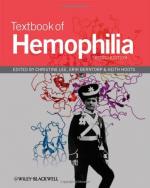|
This section contains 857 words (approx. 3 pages at 300 words per page) |

|
Suffering an occasional cut, scratch, or bruise is a normal consequence of life. When there is damage to the skin and a blood vessel ruptures, bleeding occurs. The human body is then able to initiate a series of reactions which cause the bleeding to stop. First, platelet cells in the blood move toward and attach to the site of the wound. The platelets are further held in place by strands of fibrin. The formation of the strands is the key event in a complex series of enzymatic reactions that are still somewhat of a mystery today. Without this cascade clotting process, people would be in danger of bleeding to death from very minor injuries.
However, the scenario described above could be fatal for a person afflicted with hemophilia. The term hemophiliac, coined by the German physician Johann Schönlein (1793-1864) in 1828, is made up of Greek and...
|
This section contains 857 words (approx. 3 pages at 300 words per page) |

|


